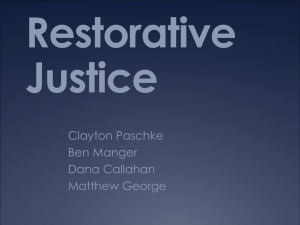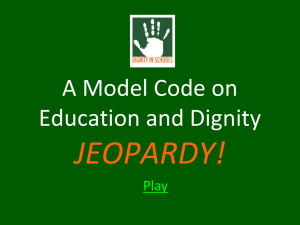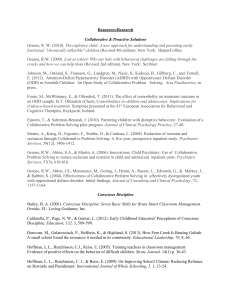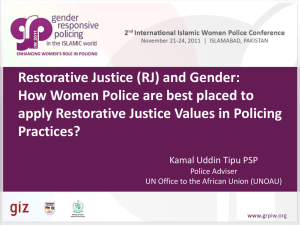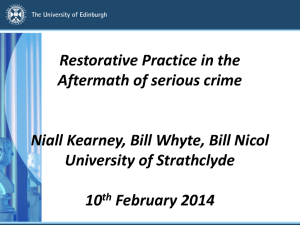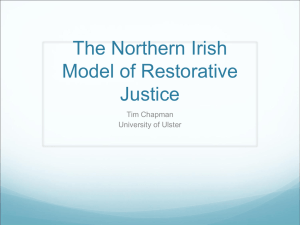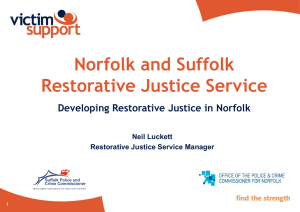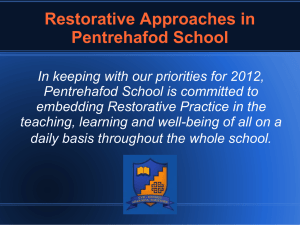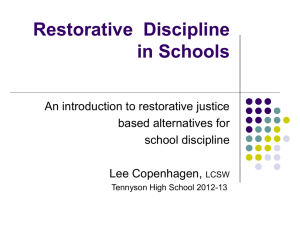Restorative Justice - Managing Conflict in Education
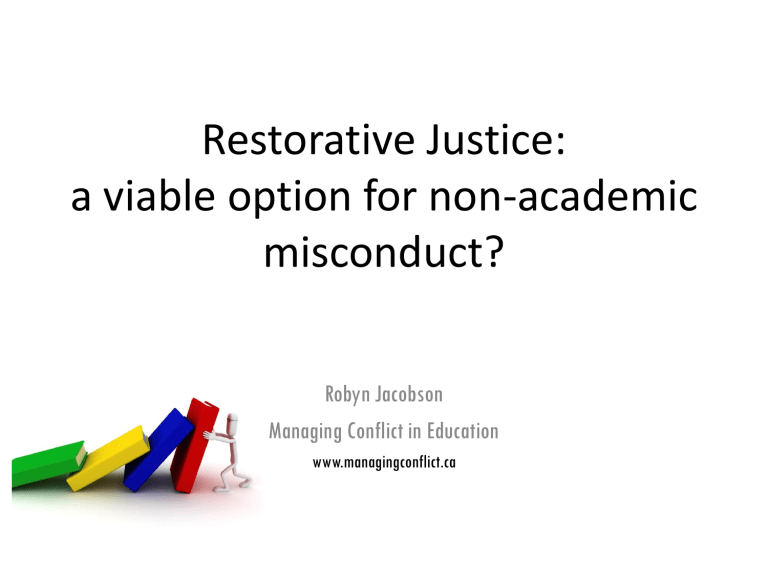
Restorative Justice: a viable option for non-academic misconduct?
Robyn Jacobson
Managing Conflict in Education www.managingconflict.ca
GUILTY
NOT
GUILTY
Do you recognize any of these terms from your Code of Conduct?
Guilty
Conviction at Trial
Not Guilty
Trial de novo Award costs
Stay of decision
Frivolous, vexatious or without foundation
Motion Disclosure
Plaintiff Defendant
Opening Statement Closing Statement
Oaths
Summons
Affirmations
Notice of Appeal
Grounds of Appeal
Binding Jurisdiction
Original and Appellate Jurisdiction
“Nothing is admissible in evidence at a hearing that would be inadmissible in a court by reason of any privilege under the law of evidence or by statute.”
Reframing Language Found in Traditional
Campus Judicial Affairs Programs
Existing Language
• Judicial Affairs
• Charge
• Prehearing
• Evidence
• Guilty/not guilty
• Sanctions
• Appeals
• Hearing officer
• Legal counsel
• Accused
• Victim
Reframed Language
• Student Conduct Administration, Conduct and Conflict Resolution Process
• Conduct, referral, conduct question
• Administrative meeting, conference
• Sharing of information
• Responsible/not responsible
• Restorative or educational measures or community actions
• Individual and process safeguards
• Facilitator
• Advisor/advocate
• Respondent
• Complainant, harmed party
Nancy Geist Giacomini, “Incorporating Principles of Conflict Resolution and Social Justice into Formal Student
Conduct Code Pathways” in Jenniufer Meyer Schrage & Nancy Geist Giacomini, Reframing Campus Conflict:
Student Conduct Practice Through a Social Justice Lens at 190.
Spectrum of Resolution Options
Jennifer Meyer Schrage & Nancy Geist Giacomini, Reframing Campus Conflict: Student Conduct Practice Through a Social
Justice Lens (Virginia: Stylus Publications, 2009).
What is
[http://www.novaservices.org/restorative_justice.htm]
Restorative Justice?
Retributive Justice
Crime is a violation of the state, defined by lawbreaking and guilt. Justice determines blame and administers pain in a contest between the offender and the state directed by systemic rules.
Restorative Justice
Crime is a violation of people and relationships. It creates obligations to make things right. Justice involves the victim, offender, and the community in a search for solutions which promote repair, reconciliation, and reassurance.
Howard Zehr, Changing Lenses: A New Focus for Crime and Justice (Scottsdale, Pa.: Herald
Press, 1990) at 181.
Retributive Justice
Focuses on:
• The offence committed
• The offender
Questions:
[http://www.topnews.in/law/files/jail.jpg]
What offence has been committed?
Who is guilty?
What punishment should be imposed?
Restorative Justice
Focuses on:
• The needs of the victim (person harmed)
• The community
(as well as the person who caused the harm)
Questions:
What harm has been done?
How can this be remedied?
[http://camosun.ca/images/fnes/circle_group.jpg]
Who is responsible for making things right?
Restorative Justice can...
• Build community
• Align beliefs of the university community with the expected behaviour
• Give legitimacy to the process of dealing with non-academic misconduct
[Restorative Justice] certainly has great potential for being effectively adapted to the unique culture and needs of university members and community. Discussion and outcomes generated by the people directly affected by a student’s conduct can help meet the University’s educational mission, have a greater emotional impact and seem more valid to all involved than outcomes imposed by administrators or as a result of bureaucratic processes.
Bill Warters, with Tom Sebok and Andrea Goldblum,
“Making Things Right: Restorative Justice Comes to Campuses” http://techknowtools.wordpress.com/2009/02
Restorative Justice is not appropriate for all offences
• where student does not take responsibility for the offence
• victimless crimes
• where beliefs are not aligned
Spectrum of Resolution Options
Jennifer Meyer Schrage & Nancy Geist Giacomini, Reframing Campus Conflict: Student Conduct Practice Through a Social
Justice Lens (Virginia: Stylus Publications, 2009).
Restorative justice processes help educate community members about the need for civic commitment and build student capacity for evaluating the impact of their behavior on the community. They also legitimate college policies by creating not only due process, but also consensus around behavioural standards and equitable responses to misconduct. Offender accountability is central, but it is balanced with a concern for integration – which is defined by the offender’s ability to regain trust through demonstrated good citizenship.
David R. Karp, “Introducing Restorative Justice to the Campus Community” in David R. Karp &
Thom Allena, Restorative Justice on the College
Campus http://www.temple.edu/students/adm/Community.jpg
Thank You
Robyn Jacobson
Managing Conflict in Education www.managingconflict.ca

